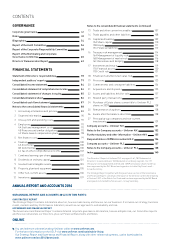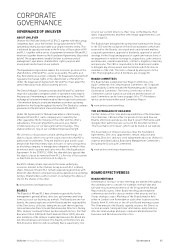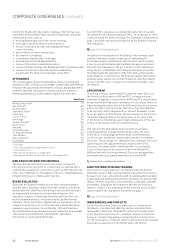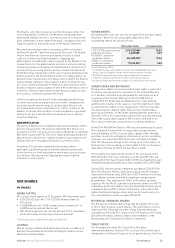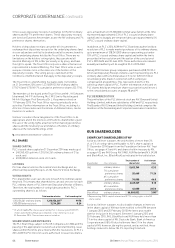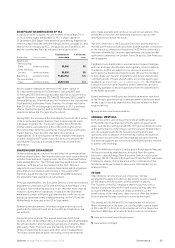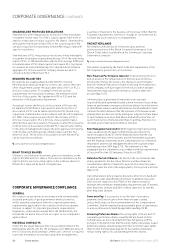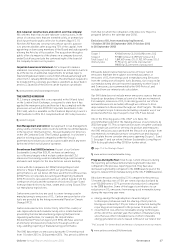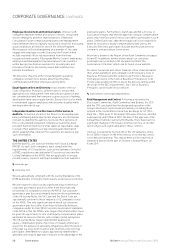Unilever 2014 Annual Report Download - page 13
Download and view the complete annual report
Please find page 13 of the 2014 Unilever annual report below. You can navigate through the pages in the report by either clicking on the pages listed below, or by using the keyword search tool below to find specific information within the annual report.
DESRIPTION OF RISK WHAT WE ARE DOIN TO MANAE THE RISK
BRAND PREFERENE
As a branded goods business, Unilever’s success depends on
the value and relevance of our brands and products to consumers
across the world and on our ability to innovate and remain
competitive.
Consumer tastes, preferences and behaviours are constantly
changing and Unilever’s ability to anticipate and respond to these
changes and to continue to differentiate our brands and products
is vital to our business.
We are dependent on creating innovative products that continue
to meet the needs of our consumers. If we are unable to innovate
effectively, Unilever’s sales or margins could be materially
adversely affected.
We continuously monitor external market trends and collate
consumer, customer and shopper insight in order to develop
category and brand strategies.
Our strategy focuses on investing in markets and segments which
we identify as attractive because we have already built, or are
confident that we can build, competitive advantage.
Our Research and Development function actively searches for ways
in which to translate the trends in consumer preference and taste
into new technologies for incorporation into future products.
Our innovation management process deploys tools, technologies
and resources to convert category strategies into projects and
category plans, develop products and relevant brand
communication and successfully roll out new products
to our consumers.
PORTFOLIO MANAEMENT
Unilever’s strategic investment choices will affect the long-term
growth and profits of our business.
Unilever’s growth and profitability are determined by our portfolio
of categories, geographies and channels and how these evolve
over time. If Unilever does not make optimal strategic investment
decisions then opportunities for growth and improved margin
could be missed.
Our Compass strategy and our business plans are designed to
ensure that resources are prioritised towards those categories
and markets having the greatest long-term potential for Unilever.
Our acquisition activity is driven by our portfolio strategy with
a clear, defined evaluation process.
SUSTAINABILITY
The success of our business depends on finding sustainable
solutions to support long-term growth.
Unilever’s Vision to double the size of our business while reducing
our environmental footprint and increasing our positive social
impact will require more sustainable ways of doing business.
This means reducing our environmental footprint while increasing
the positive social benefits of Unilever’s activities. We are dependent
on the efforts of partners and various certification bodies to achieve
our sustainability goals. There can be no assurance that sustainable
business solutions will be developed and failure to do so could
limit Unilever’s growth and profit potential and damage our
corporate reputation.
The Unilever Sustainable Living Plan sets clear long-term
commitments to improve health and well-being, reduce
environmental impact and enhance livelihoods. Underpinning
these are targets in areas such as hygiene, nutrition, sustainable
sourcing, fairness in the workplace, opportunities for women and
inclusive business as well as greenhouse gas emissions, water and
waste. These targets and more sustainable ways of operating are
being integrated into Unilever’s day-to-day business.
Progress towards the Unilever Sustainable Living Plan is monitored
by the Unilever Leadership Executive and the Boards. The Unilever
Sustainable Living Plan Council, comprising six external specialists
in sustainability, guides and critiques the development of our strategy.
USTOMER RELATIONSHIPS
Successful customer relationships are vital to our business and
continued growth.
Maintaining strong relationships with our customers is necessary
for our brands to be well presented to our consumers and available
for purchase at all times.
The strength of our customer relationships also affects our ability
to obtain pricing and secure favourable trade terms. Unilever may
not be able to maintain strong relationships with customers and
failure to do so could negatively impact the terms of business with
the affected customers and reduce the availability of our products
to consumers.
We build and maintain trading relationships across a broad
spectrum of channels ranging from centrally managed
multinational customers through to small traders accessed
via distributors in many developing countries.
We develop joint business plans with our key customers that include
detailed investment plans and customer service objectives and we
regularly monitor progress.
We have developed capabilities for customer sales and outlet design
which enable us to find new ways to improve customer performance
and enhance our customer relationships.
50 Unilever Annual Report and Accounts 2014Governance
RISKS CONTINUED


